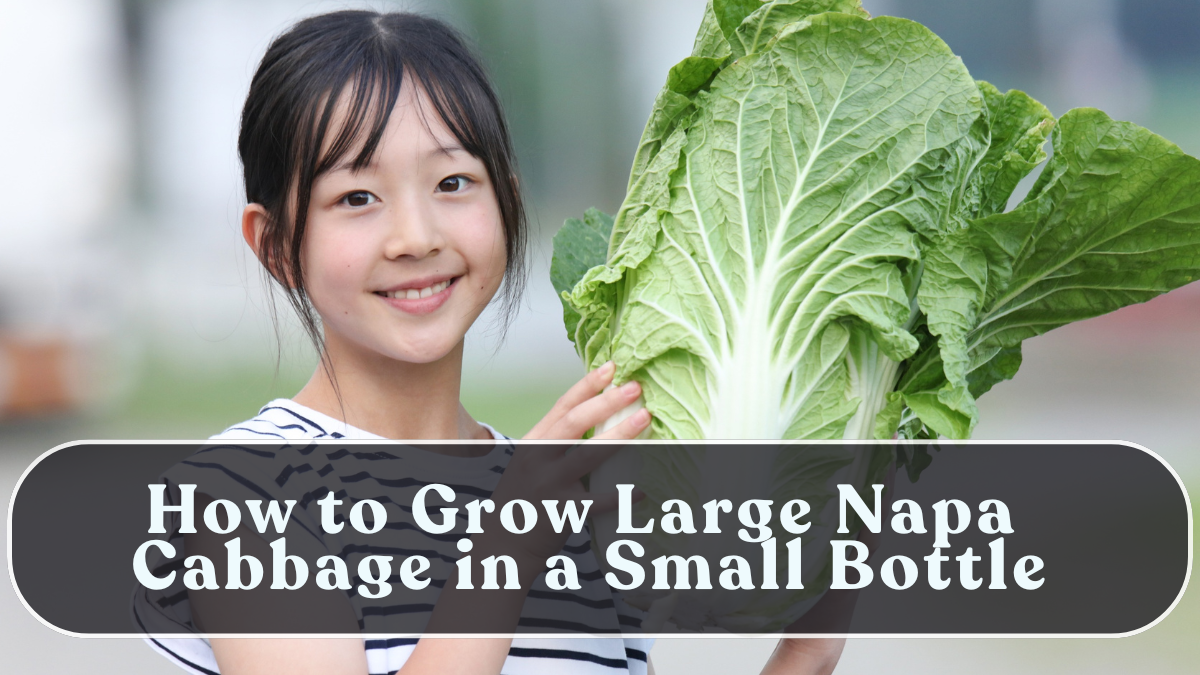Think growing large napa cabbage in a small plastic bottle is impossible? Think again! With the right soil mix, watering, and sunlight, you can grow lush, compact cabbages even in tight urban spaces. This clever container gardening trick turns ordinary waste bottles into productive mini-gardens—perfect for balconies or kitchen corners.
Here’s the complete method to grow fresh, crisp napa cabbage at home with zero waste.

Why Napa Cabbage?
Napa cabbage, also known as Chinese cabbage, is a cool-weather vegetable that grows quickly and tastes mild and tender. It’s perfect for salads, stir-fries, or kimchi. The best part? It doesn’t need much space—making it ideal for bottle or container gardening.
Plus, growing it yourself ensures it’s pesticide-free, organic, and fresh, straight from your mini garden to your plate.
Choosing the Bottle and Setup
Pick a 2–5 liter plastic bottle (like a water or soda bottle).
-
Cut off the top to make an opening wide enough for planting.
-
Drill or poke 3–4 small drainage holes at the bottom.
-
Clean thoroughly to remove any residues.
-
Place a few small stones or broken pieces of terracotta at the bottom for drainage.
If you’re using multiple bottles, you can line them up vertically on a rack to save space—creating your own vertical kitchen garden.
Soil Mix for Healthy Growth
Napa cabbage grows best in rich, well-draining soil. Prepare a nutrient-packed mix using:
-
40% garden soil
-
30% compost or cow dung manure
-
20% cocopeat
-
10% sand or perlite
Mix well and fill the bottle, leaving about 2 inches of space at the top. Add a pinch of bone meal or wood ash to improve calcium and prevent tip burn on leaves.
Planting and Germination
You can grow napa cabbage from seeds or small seedlings.
-
Sow 2–3 seeds in the center of the bottle, about ½ inch deep.
-
Keep the bottle in partial shade and mist gently with water daily.
-
Seeds will germinate within 5–7 days.
-
Once seedlings reach 3 inches, keep the strongest one and remove the rest.
Move the bottle to a sunny location that receives at least 5–6 hours of light daily.
Watering and Feeding
Napa cabbage needs consistent moisture for soft, tender leaves.
-
Water every 2–3 days or when the top inch of soil feels dry.
-
Avoid overwatering—roots can rot easily in containers.
-
Feed every 15 days with organic fertilizer or compost tea.
Adding liquid seaweed or vermicompost extract boosts leafy growth and prevents yellowing.
Sunlight and Temperature
This vegetable thrives in cool temperatures (10°C–24°C) and partial sunlight. Too much heat can cause it to bolt (flower prematurely). In warm areas, keep bottles under a shade net or balcony roof to maintain cooler conditions.
Pest and Disease Prevention
Common pests include aphids and cabbage worms. Protect plants naturally by:
-
Spraying neem oil or garlic-chili spray once a week.
-
Checking under leaves for eggs or larvae.
-
Ensuring proper airflow between bottles.
Good drainage and balanced watering prevent fungal diseases like root rot or powdery mildew.
Harvesting
Your napa cabbage will be ready for harvest in 60–75 days.
-
Harvest when the head feels firm and compact when squeezed.
-
Cut it off at the base with a sharp knife.
-
Leave the roots in the soil—you might get a few smaller regrowths later!
Freshly harvested napa cabbage has a sweet, crunchy texture and is perfect for salads, soups, or fermenting into kimchi.
Conclusion
Growing napa cabbage in a plastic bottle proves that you don’t need land or large pots to enjoy homegrown vegetables. With minimal space and recycled materials, you can create a green, productive setup right at home.
It’s eco-friendly, cost-effective, and incredibly rewarding—a perfect DIY gardening project for anyone who loves fresh, healthy produce without waste.
FAQs
How long does it take to grow napa cabbage?
Around 60–75 days from sowing to harvest, depending on climate.
Can I grow napa cabbage indoors?
Yes, near a bright window or balcony with at least 5–6 hours of sunlight.
How often should I water it?
Water every 2–3 days, keeping the soil moist but not soggy.
What fertilizer works best?
Use compost tea or liquid seaweed fertilizer every two weeks.
Can I regrow it after harvest?
Yes, if you leave the roots intact, new side shoots may regrow for a smaller second harvest.
